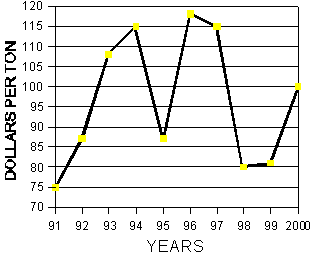Alfalfa Report
Yuma County, Arizona
November 20, 2000
Yuma County Office
2200 W. 28th Street, Ste. 102
Yuma, AZ 85364
(520) 726-3904
(520) 726-8472 FAX
Production Update:
PDF version, 14KB
Frost Management: Frost-damaged alfalfa has lower quality due to leaf loss, lower digestibility, and decreased mineral content. Frost-damaged alfalfa may also accumulate toxic levels of nitrates in rare cases. Water application during freezing temperatures can raise the temperature, but waterlogging can produce negative effects. In the case of alfalfa, the best protection against frost is a healthy crop. Severe frosts can kill the tops of the alfalfa plant and new growth must occur from the base of the plant. Cutting alfalfa after a frost can stimulate this new growth near the base of the plant, but the new growth is then susceptible to subsequent frosts.
Insect Management: Egrets, Ibis, gulls, and redwing black birds are commonly seen in alfalfa fields. Birds are important predators of various insect pests in alfalfa including the very damaging granulate cutworm. Egrets, Ibis and gulls are often seen at the leading edge of irrigation water, eating crickets and worms forced to move or drown. Black birds eat cutworms, other worm pests, and aphids on alfalfa stems.
Weed Control: Perennial weeds such as nutsedge and bermudagrass
and summer annuals, should be going dormant or dying now. This is a good
time to take note of where they are to be prepared to start controlling
them in the spring with preemergent treatments.
| Market Summary |
High
|
Low
|
Average
|
Off grade
|
| Past 2 Weeks (Nov. 7 to Nov. 20, 2000) |
105
|
90
|
100
|
70-90
|
| Last Year (Nov. 7 to Nov. 20, 1999) |
87
|
70
|
81
|
60-70
|
10 Year Summary (November 7, to November 20, 1991-2000):

Issued in furtherance of Cooperative Extension work, acts of May 8 and June 30, 1914, in cooperation with the U.S. Department of Agriculture, James A. Christenson, Director Cooperative Extension, College of Agriculture and Life Sciences, The University of Arizona.
The University of Arizona is an equal opportunity, affirmative action institution. The University does not discriminate on the basis of race, color, religion, sex, national origin, age, disability, veteran status, or sexual orientation in its programs and activities.
Any products, services, or organizations that are
mentioned, shown, or indirectly implied in this web document do not imply
endorsement by The University of Arizona.
Information provided by:
Barry Tickes, btickes@ag.arizona.edu Extension Agent, Yuma County
Michael Ottman, mottman@ag.arizona.edu Agronomy Specialist
College of Agriculture, The University of Arizona.
Eric Natwick, etnatwick@ucdavis.edu UCCE Imperial County - Farm Advisor
University of California, Davis, CA.
Material written November 20, 2000.
Forages: Crop Mgmt | Soil Mgmt | Irrigation | Alfalfa Reports | Insects | Diseases | Weeds | Pesticides
Home | Other Crops | Forages
For more Arizona Production Ag Information:
Home | Cotton | Veggies| Forages | Grains | Citrus | Crop x Crop | Insects | Diseases| Weeds | Pesticides | News | Weather | Research | Photos | Contacts | General Info. | Site Map
Copyright © 2001 University of Arizona,
College of Agriculture and Life Sciences
Webmaster: Al Fournier (fournier@ag.arizona.edu)